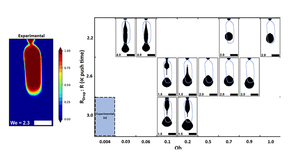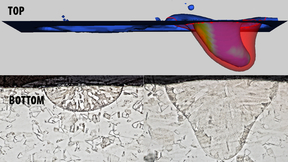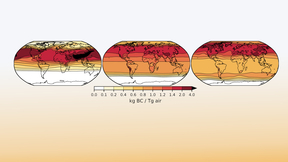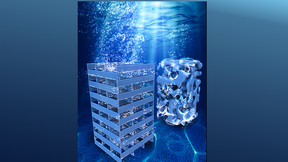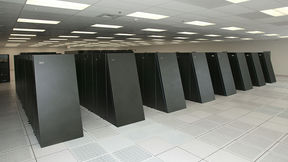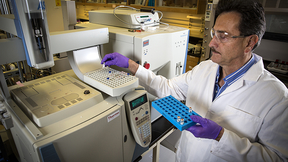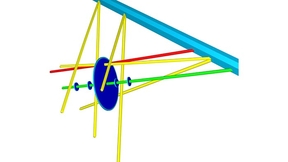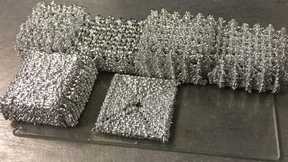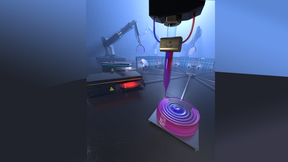Back
Physical and Life Sciences
Lab study of droplet dynamics advances 3D printing
A team of Lawrence Livermore National Laboratory (LLNL) scientists has simulated the droplet ejection process in an emerging metal 3D printing technique called “Liquid Metal Jetting” (LMJ), a critical aspect to the continued advancement of liquid metal printing technologies. In the paper, the team describes the simulating of metal droplets during LMJ, a novel process in…
Researchers measure electron emission to improve understanding of laser-based metal 3D printing
Lawrence Livermore National Laboratory (LLNL) researchers have taken a promising step in improving the reliability of laser-based metal 3D printing techniques by measuring the emission of electrons from the surface of stainless steel during laser processing. Researchers collected thermionic emission signals from 316L stainless steel under laser powder bed fusion (LPBF)…
Former LLNL intern makes history when she is named first Black woman to lead brigade at Naval Academy
Sydney Barber, former intern at Lawrence Livermore National Laboratory (LLNL), is making history at the United States Naval Academy. It was recently announced that 1st class midshipman Barber will become brigade commander next semester, the highest leadership position in the brigade, making her the first Black woman to be named in the role. The first female brigade…
Lab scientists among most cited researchers worldwide
Fifty-seven researchers from Lawrence Livermore National Laboratory (LLNL) were among the top 2 percent of the most cited researchers worldwide throughout their careers, according to research on metascience by Stanford University. Metascience is the "study of studies" using scientific methods. Stanford University professor John Loannidis worked alongside U.S.-based Kevin…
Examining climate effects of regional nuclear exchange
A team of Lawrence Livermore National Laboratory (LLNL) researchers has found that the global climatic consequences of a regional nuclear weapons exchange could range from a minimal impact to more significant cooling lasting years. The five LLNL scientists examined the potential for global climate changes from large urban fires ignited in a hypothetical regional nuclear…
Great People: Carlos Valdez
Growing up in Lima, Peru, Livermore chemist Carlos Valdez excelled in art and soccer. But his first love was science.
3D printed electrodes free the gas
Alkaline water electrolysis has been touted as a path to establish a hydrogen economy by converting intermittent renewable energies into clean hydrogen-based chemical energy. However, current technology has achieved only low current densities and voltage efficiencies. To make electrolysis more resourceful, a Lawrence Livermore National Laboratory (LLNL) team partnered with…
Meteorites might have kick-started life on early Earth
The incorporation of the biologically vital element phosphorus into material found in living species may have formed during impact from astrophysical bodies on early Earth. NASA’s Exobiology Program has awarded Lawrence Livermore National Laboratory (LLNL) senior scientist Nir Goldman a three-year grant to research meteorite impacts on Earth. Goldman is seeking to…
LLNL, IBM win SC20 ‘Test of Time’ for Blue Gene/L
A team of current and former Lawrence Livermore National Laboratory (LLNL) and IBM scientists won the annual “Test of Time” award at the 2020 Supercomputing Conference on Nov. 19 for a paper outlining LLNL’s Blue Gene/L supercomputer. Published by the Supercomputing Conference in 2002, the paper was the first peer-reviewed overview article to disclose details of Blue Gene…
The Worldwide Effort to Ban Chemical Weapons
The Forensic Science Center is an important ally in the international endeavor to prohibit chemical warfare agents.
Tapping the Earth’s Heat for Clean Energy
Working in a deep underground tunnel, researchers are learning how to turn heat from impermeable rock into clean, low-carbon-emitting power.
Drop by Drop: A Promising Method for Printing Metal Parts
A novel additive manufacturing technique applies tiny droplets of molten metal layer by layer.
HPC4Energy Innovation kicks off fall 2020 solicitation
The High Performance Computing for Energy Innovation (HPC4EI) Program, managed by Lawrence Livermore National Laboratory (LLNL) for the U.S. Department of Energy (DOE), is seeking new industry proposals for short-term projects that could benefit from world-class DOE high performance computing (HPC) and expertise. Under the fall 2020 HPC4EI solicitation, DOE’s Office of…
3D-printed glass enhances optical design flexibility
Lawrence Livermore National Laboratory (LLNL) researchers have used multi-material 3D printing to create tailored gradient refractive index glass optics that could make for better military specialized eyewear and virtual reality goggles. The new technique could achieve a variety of conventional and unconventional optical functions in a flat glass component (with no surface…
Model for COVID-19 drug discovery a Gordon Bell finalist
A machine learning model developed by a team of Lawrence Livermore National Laboratory (LLNL) scientists to aid in COVID-19 drug discovery efforts is a finalist for the Gordon Bell Special Prize for High Performance Computing-Based COVID-19 Research. Using Sierra, the world’s third fastest supercomputer, LLNL scientists created a more accurate and efficient generative…
Tiny tubes come in big packages
Membrane-based systems have great potential as low energy alternatives in applications like desalination, pharmaceutical recovery, purification and waste treatment. Scientists at Lawrence Livermore National Laboratory (LLNL) have created the largest defect-free membranes reported to date that fully exploit the unique mass transport properties of carbon nanotubes as flow…
LLNL wins two FLC awards for tech transfer
Two teams of Lawrence Livermore National Laboratory (LLNL) scientists and engineers, each supported by a Lab business development executive, have garnered regional awards for technology transfer. This year’s awards, one for outstanding technology development and the other for an outstanding partnership, will be presented next week during the Federal Laboratory Consortium’s…
Solar system formed in less than 200,000 years
A long time ago — roughly 4.5 billion years — our sun and solar system formed over the short time span of 200,000 years. That is the conclusion of a group of Lawrence Livermore National Laboratory (LLNL) scientists after looking at isotopes of the element molybdenum found on meteorites. The material that makes up the sun and the rest of the solar system came from the…
Lab will play key role in upcoming battery summit
Five Lawrence Livermore National Laboratory (LLNL) employees, including Director Bill Goldstein, will play key roles in the sixth annual Bay Area Battery Summit (BABS) slated to be held virtually next week. This year’s sixth annual BABS, co-sponsored by LLNL, New Energy Nexus and CalCharge, will draw together investors, policymakers, researchers and entrepreneurs with an…
LLNL welcomes 'Ruby' supercomputer for national nuclear security mission and COVID-19 research
Lawrence Livermore National Laboratory (LLNL), along with partners Intel, Supermicro and Cornelis Networks, have deployed “Ruby,” a high performance computing (HPC) cluster that will perform functions for the National Nuclear Security Administration (NNSA) and support the Laboratory’s COVID-19 research. Funded by NNSA’s Advanced Simulation and Computing (ASC) program, the…


